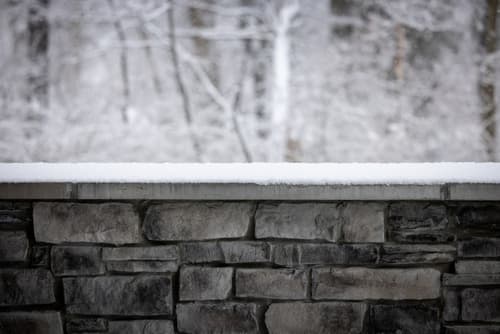Retaining walls often look like decorative hardscaping in a yard, strategically positioned to divide the outdoor space into sections like the patio and flower beds. Their true purpose of a retaining wall, though, is far more significant, serving as a structure that keeps sloping earth in its place. Natural elements place horizontal pressure on a retaining wall and an incredible amount of weight, making it critical to choose an experienced landscaping company to design and install this construction.
Benefits of Retaining Walls in Winter
Retaining walls are sometimes referred to as gravity wall, cantilever wall, or anchored wall. They usually stand higher than three feet and require a firm footing to build its secure foundation which includes a drainage pipe and, typically, a stone front. Their benefits are many:
- Prevent soil erosion. Homes situated on a slope need a retaining wall to protect their foundation by holding back soil and maintaining the soil’s integrity, so it doesn’t get washed away by water runoff. The wall acts as a tough drainage system that stops runoff from making its way through the yard and leading to leaks or foundation damage.
- Improve unusable yard. If part of your yard is unusable because it’s waterlogged or swampy, a retaining wall that is firmly situated in the ground around this area can help mitigate this problem and expand outdoor living space.
- Enhance aesthetics. Retaining walls are important and serve their purpose, but are also an attractive feature. The wall adds visual appeal to a yard and can be designed creatively and combined with the planting of shrubs, flowers, trees, and other landscaping.
- Stop infringement. Once a retaining wall is in place and yard slope or encroaching hillside has been stopped, the newly usable space can be transformed into a flat area suitable for a patio, patio extension, garden, or other hardscaping addition.
Protect Retaining Walls from Winter Damage
Freeze-thaw cycles and other winter environmental factors can be potentially damaging to a property. Retaining walls withstand extra stress in the face of snow, ice, and freezing temperatures, but they are built strong to manage it all. You can help protect your retaining walls from winter damage and maintain stability and longevity with the following efforts:
- Check your drainage system for backup or clogs.
- Look for cracks, bulges, or areas that have shifted.
- Stay alert for signs of wear or weakness.
- Safely remove snow, debris, and other obstructions from the base of the wall.
- Schedule a professional inspection and sealant for the wall.
Support Your Retaining Wall with Help from Visionary Landscaping
Weak areas in your retaining wall could let in moisture, contribute to buildup, and impact your drainage system. It is necessary to have gaps sealed and identify and repair other problems before winter weather arrives.
Contact Visionary Landscaping in Shelby Township, MI, to learn more about protecting your retaining wall in winter and taking care of all your outdoor hardscaping. Allow us to conduct an inspection, carry out repairs, and keep your yard healthy in time for the coldest months in Michigan.

